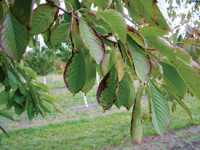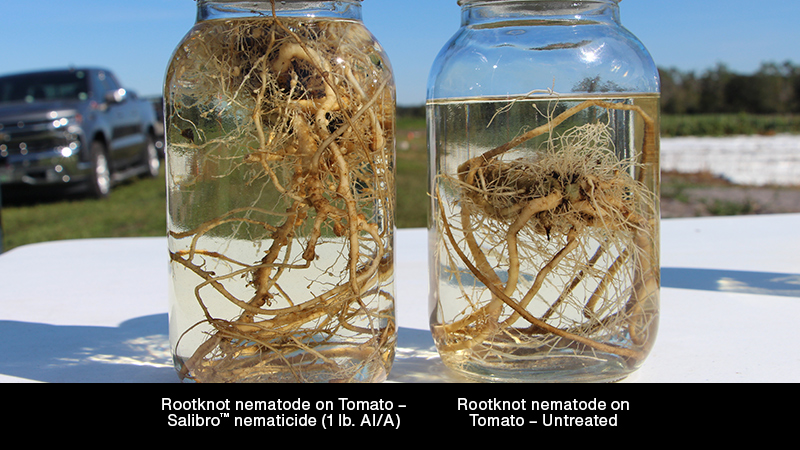Add Nitrogen To Boost Cherry Quality

For the study, “Fall Foliar Nitrogen Applications for Sweet and Tart Cherries,” Lang and his colleagues examined the effect of nitrogen on several aspects of bearing cherry trees. The research team measured nitrogen levels in fruiting spur buds in fall, winter, and spring as well as in young fruits, plus spur leaf size and total leaf area per spur, fruit set, fruit size, fruit firmness, and shoot cold hardiness.
Following preliminary studies in sweet cherries during 2005-06 (which helped determine rates less likely to cause the potential phytotoxicity seen in the photo on this page), foliar treatments of low biuret urea were imposed in 2007 from late summer throughout the fall, about 10 days to 2½ weeks apart, so that the researchers could examine application timings and their potential effects on the natural progression of fall cold acclimation in the trees.
The research team initiated the study in several blocks, applying foliar nitrogen to three sweet cherry orchards: an Ulster block at MSU’s Clarksville Horticultural Experiment Station, an Ulster block at a grower cooperator site in the Traverse City, MI, area, and both a Kristin block and a Montmorency block at the Northwest Michigan Horticultural Research Station.
Beginning Aug. 18, the nitrogen treatments were applied at a rate of 13 to 23 pounds of actual nitrogen per acre per application (depending on trial site), replicating each sweet cherry treatment five to six times in a randomized block design. Untreated trees were sampled at each application timing to serve as control treatments that were given no fall nitrogen.
Trees in the tart cherry block received one of the following three treatments: an untreated control, one foliar urea application at 23 pounds actual nitrogen per acre, or two foliar urea applications done one week apart at 23 pounds nitrogen per acre. The tart cherry treatments were set up in a randomized block design with four replications.
Mixed Results
The researchers followed up the treatments by collecting fruiting spurs in fall and winter for nitrogen analysis, shoots in fall and winter for cold hardiness analysis, and young green fruit and leaves in the late spring for growth and nitrogen content analysis. The young green fruit samples were collected post shuck-split on June 5, and 10 leaves per tree were collected from two-year-old non-fruiting spurs in early August. Spur leaf size was determined after leaf elongation was complete in mid-June, measuring leaves on 10 different two-year-old non-fruiting spurs per tree. Leaf areas were estimated from the length and width of the largest leaf in the spur.
 Although the datasets are still being fully interpreted, in general, fruiting buds from the treated trees had significantly higher nitrogen content, with two applications of fall foliar nitrogen being more effective than a single application. The treatments resulted in larger spur leaves for sweet cherry but not for tart cherry.
Although the datasets are still being fully interpreted, in general, fruiting buds from the treated trees had significantly higher nitrogen content, with two applications of fall foliar nitrogen being more effective than a single application. The treatments resulted in larger spur leaves for sweet cherry but not for tart cherry.
Lang and his colleagues did not observe higher yields in any of the nitrogen-treated sweet cherry blocks nor in the Montmorency orchard after one year. The researchers believe that there were compounding factors of differential crop loads and pruning severities across the test blocks that led to a very high variability in the treatment yield data. They may need to observe the trees over a period of several years of treatment in order to determine if the application of nitrogen has any impact on yield.
There were no differences in the amount of nitrogen contained in the sweet cherry leaves collected in late summer, which is not surprising given that the main effects of fall foliar nitrogen applications would be manifested primarily in early spring.
The research team determined the average weight per cherry by collecting 100 fruit, with 25 from each quadrant of the tree canopy, for weighing on a digital scale. The Montmorency and sweet cherry trees that received nitrogen applications produced slightly heavier fruit, though the differences were not statistically different. The application of nitrogen had a slight, though again statistically insignificant, impact on fruit firmness as well, with slightly higher firmness values for the treated trees. These experiments will be repeated over the next two years to obtain less variable data and confirm whether the differential fruit quality data are significant or not.
Withstanding The Cold
Finally, with the assistance of Lynne Sage, technician, and Theoharis Ouzounis, graduate student, in the MSU Horticulture department, the MSU team measured cold acclimation of the Clarksville-based Ulster trees during the fall (September to December) and cold hardiness of the NWHS-based Montmorency trees in November and February. Following controlled freezing at progressively lower temperatures in a programmable freezer, tissue mortality was determined.
The data they collected suggests that sweet cherry trees that received applications of fall foliar nitrogen began acclimating earlier and to a greater degree than untreated trees, and also that tart cherry trees gained greater cold hardiness in fall that persisted through February.
Again, some of the data from these first-year cold hardiness studies was variable with regard to the timing of the nitrogen applications versus the positive effects, but it is important to note that all differences tended to be positive or neutral when applications were made from the beginning of September through fall.
The researchers concluded that two applications of fall foliar nitrogen improved cold hardiness compared with a single application. “While still somewhat preliminary regarding recommended application rates,” Lang notes, “these experimental results are exciting in that fall foliar urea applications clearly increase the storage nitrogen levels in fruiting spurs of both tart and sweet cherries, which is likely to be important for several early spring growth activities. It appears that significant enhancements of fall cold acclimation and winter hardiness are an unexpected benefit, as well.”









